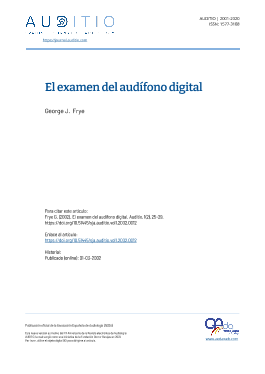Digital hearing-aid examination
DOI:
https://doi.org/10.51445/sja.auditio.vol1.2002.0012Keywords:
digital hearing aids, hearing-aid analyzer, hearing-aid fitting, ICRAAbstract
There is a widespread notion among hearing-aid fitting professionals that the response of digital hearing aids cannot be examined. This idea is erroneous since we have the technology to carry out these studies. In this article, we present the necessary methodology for the examination of digital hearing aids using pure and composite tone signals. This methodology allows the interactive analysis of the response of the noise reduction filters characteristic of digital hearing aids. Thus, a review of the analysis of the responses is carried out through the use of spectography techniques.
Translated with permission of the author by Franz Zenker. Original Article: Frye GJ. Testing Digital Hearing Instruments [en linea]. Hearing Review. 13 link
Downloads
Visibility and Altmetrics
Metrics
Global Statistics ℹ️
|
1156
Views
|
452
Downloads
|
|
1608
Total
|
|
References
Frye GJ: (1990). A Perspective on digital hearing instruments. Hearing Review; 6 (10):61.
Heide J: (1987). Testing electroacustic per-formance of ASP and nonlinear hearing aids. Hearing Journal; 40 (4).

Published
Versions
- 2021-09-15 (2)
- 2002-03-01 (1)
How to Cite
Issue
Section
License
Copyright (c) 2002 Auditio

This work is licensed under a Creative Commons Attribution 3.0 Unported License.
All articles will be published under the open Creative Commons Attribution (CC-BY) license. This license allows others to share and adapt the content, even for commercial purposes, as long as appropriate credit is given to the authors and the journal. By submitting their manuscript, authors retain copyright but grant the journal the right to make the first publication under this license.
More information about this license is available at: https://creativecommons.org/licenses/by/4.0/
Articles published between 2001 and 2020
The texts published in this journal in the section "AUDITIO 2001-2020" are subject - unless otherwise indicated - to a Creative Commons Attribution 3.0 Spain license. You can copy, distribute, communicate them publicly, make derivative works and commercial uses provided that you acknowledge the credits of the works (authorship, name of the journal, publishing institution) in the manner specified by the authors or by the journal. The full license can be consulted at http://creativecommons.org/licenses/by/3.0/es/deed.es.









